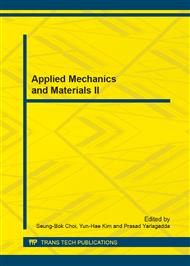p.299
p.303
p.307
p.315
p.321
p.325
p.330
p.337
p.341
Dynamic Characteristics Analysis and Modeling of Giant Magnetostrictive Actuator Turning System
Abstract:
Based on DEFORM finite element software, the model of turning process of GMA was built, and the relation function among turning speed, turning depth and turning force of GMA turning system was achieved. Then, considering the turning force model, the dynamic equation of the turning system was established and the time domain and frequency domain of GMA turning system were discussed with different corresponding parameters. Results show that turning speed and turning depth have apparent effects on turning force of GMA turning system. Therefore, it is necessary to take the impact into consideration when analyzing dynamic characteristics of the turning system.
Info:
Periodical:
Pages:
321-324
Citation:
Online since:
December 2013
Authors:
Price:
Сopyright:
© 2014 Trans Tech Publications Ltd. All Rights Reserved
Share:
Citation:


